Around the World
July/August 2020
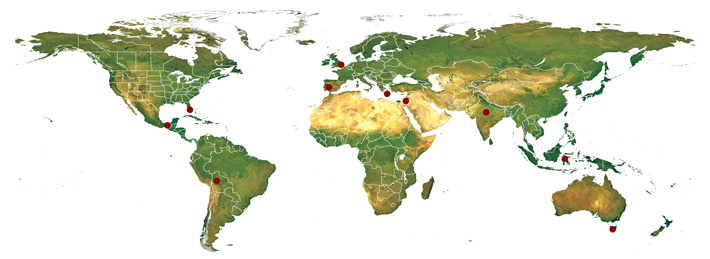

-
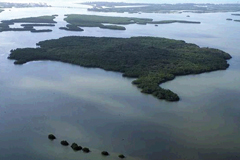 FLORIDA: The Calusa Indians, who ruled much of southern Florida in the pre-Columbian era, are known for their sophisticated engineering projects. These included artificial islands and canals at their capital of Mound Key. They also created large lagoons called watercourts out of shells and sediments. These enclosures, which date to the 14th century, acted as holding tanks, allowing the Calusa to trap and store large numbers of fish in the subtropical climate.
FLORIDA: The Calusa Indians, who ruled much of southern Florida in the pre-Columbian era, are known for their sophisticated engineering projects. These included artificial islands and canals at their capital of Mound Key. They also created large lagoons called watercourts out of shells and sediments. These enclosures, which date to the 14th century, acted as holding tanks, allowing the Calusa to trap and store large numbers of fish in the subtropical climate. -
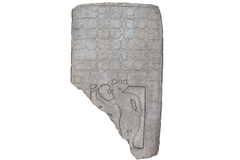 MEXICO: An inscribed stone tablet unearthed by a cattle rancher in Lacanja Tzeltal, Chiapas, has led to the discovery of a long-lost Maya city that was founded around 750 B.C. The existence of an important regional capital called Sak Tz’i’ was known from previously discovered inscriptions, but its exact location had eluded archaeologists for decades. When researchers explored the rancher’s property, they found a trove of monuments, including pyramids and a palace complex, and were able to identify the inscribed text that confirmed the site’s name.
MEXICO: An inscribed stone tablet unearthed by a cattle rancher in Lacanja Tzeltal, Chiapas, has led to the discovery of a long-lost Maya city that was founded around 750 B.C. The existence of an important regional capital called Sak Tz’i’ was known from previously discovered inscriptions, but its exact location had eluded archaeologists for decades. When researchers explored the rancher’s property, they found a trove of monuments, including pyramids and a palace complex, and were able to identify the inscribed text that confirmed the site’s name. -
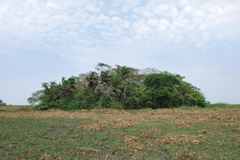 BOLIVIA: Various ancient civilizations in places such as China and the Near East are known to have independently developed agriculture thousands of years ago. New research within the Llanos de Moxos has revealed that people living in Amazonia some 10,850 years ago were also among the earliest in the world to domesticate and cultivate crops. Sediment analysis showed that the region’s inhabitants created thousands of forest islands within the otherwise treeless savannah by dumping food waste, creating fertile patches on which they were able to grow manioc, squash, maize, and other edible plants.
BOLIVIA: Various ancient civilizations in places such as China and the Near East are known to have independently developed agriculture thousands of years ago. New research within the Llanos de Moxos has revealed that people living in Amazonia some 10,850 years ago were also among the earliest in the world to domesticate and cultivate crops. Sediment analysis showed that the region’s inhabitants created thousands of forest islands within the otherwise treeless savannah by dumping food waste, creating fertile patches on which they were able to grow manioc, squash, maize, and other edible plants. -
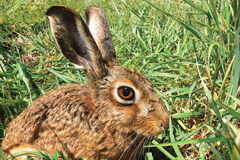 ENGLAND: There were no roast chickens or rabbit stews on the tables of Iron Age Britons. Chickens and brown hares, which are not native to the British Isles, only arrived sometime between the 5th and 3rd centuries B.C. Carefully buried intact bird and small mammal skeletal remains found in Hampshire and Hertfordshire suggest that when chickens and hares did appear, they were not viewed as a food source, but instead as exotic species. They may even have been revered and associated with deities. It was not until hundreds of years later, under Roman rule, that chickens and hares began to be farm-raised and eaten.
ENGLAND: There were no roast chickens or rabbit stews on the tables of Iron Age Britons. Chickens and brown hares, which are not native to the British Isles, only arrived sometime between the 5th and 3rd centuries B.C. Carefully buried intact bird and small mammal skeletal remains found in Hampshire and Hertfordshire suggest that when chickens and hares did appear, they were not viewed as a food source, but instead as exotic species. They may even have been revered and associated with deities. It was not until hundreds of years later, under Roman rule, that chickens and hares began to be farm-raised and eaten. -
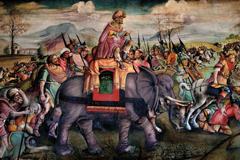 SPAIN: Before the Carthaginian general Hannibal crossed the Alps with his elephants, he defeated a group of Iberian tribes in a pivotal 220 B.C. battle fought somewhere along the Tagus River. Ancient writers record that Hannibal’s 25,000 soldiers overwhelmed an army of 100,000, but scholars have long argued over exactly where the clash took place. A new study using archaeological, historical, and geomorphological data has finally narrowed down the location to a stretch of river between the towns of Driebes and Illana in the province of Guadalajara.
SPAIN: Before the Carthaginian general Hannibal crossed the Alps with his elephants, he defeated a group of Iberian tribes in a pivotal 220 B.C. battle fought somewhere along the Tagus River. Ancient writers record that Hannibal’s 25,000 soldiers overwhelmed an army of 100,000, but scholars have long argued over exactly where the clash took place. A new study using archaeological, historical, and geomorphological data has finally narrowed down the location to a stretch of river between the towns of Driebes and Illana in the province of Guadalajara. -
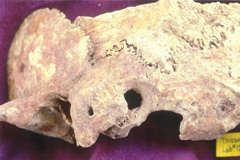 GREECE: An experienced surgeon treating a soldier on the island of Thasos tried everything to alleviate his patient’s debilitating infection, even performing a complex procedure that entailed boring holes in his skull. The man, who was buried at the site of Palaiokastro between the 4th and 7th centuries A.D., was probably a mounted archer in the Roman army. His severe infection may have been caused by a ruptured eardrum or possibly a tumor. The procedure was ultimately unsuccessful despite the doctor’s skill.
GREECE: An experienced surgeon treating a soldier on the island of Thasos tried everything to alleviate his patient’s debilitating infection, even performing a complex procedure that entailed boring holes in his skull. The man, who was buried at the site of Palaiokastro between the 4th and 7th centuries A.D., was probably a mounted archer in the Roman army. His severe infection may have been caused by a ruptured eardrum or possibly a tumor. The procedure was ultimately unsuccessful despite the doctor’s skill. -
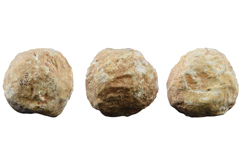 ISRAEL: Hand-size stone balls have been found at numerous early Paleolithic sites around the world, but their exact purpose has baffled experts. Microscopic analysis of wear patterns and bone residues on the surface of examples found in Qesem Cave has indicated the spheres may have been shaped and used by humans between 400,000 and 200,000 years ago to crack open animal bones. Experimental trials using replicas demonstrated just how efficient these tools would have been at accessing bone marrow, which was nutrient-rich and much sought-after.
ISRAEL: Hand-size stone balls have been found at numerous early Paleolithic sites around the world, but their exact purpose has baffled experts. Microscopic analysis of wear patterns and bone residues on the surface of examples found in Qesem Cave has indicated the spheres may have been shaped and used by humans between 400,000 and 200,000 years ago to crack open animal bones. Experimental trials using replicas demonstrated just how efficient these tools would have been at accessing bone marrow, which was nutrient-rich and much sought-after. -
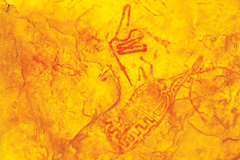 INDIA: Nearly 300 never-before-documented rock paintings were discovered across 11 sites in Madhya Pradesh. The scenes include 67 human and 80 animal figures, among them depictions of deer, rhinoceros, wild boar, and Indian bison. While animal scenes are a common motif in ancient Indian rock art, which dates back as far as 30,000 years, one of the newly documented paintings depicts a rare post-hunt scene of a deer being butchered. A human figure seems to be pulling an arrow from the fallen animal while in the process of disemboweling it.
INDIA: Nearly 300 never-before-documented rock paintings were discovered across 11 sites in Madhya Pradesh. The scenes include 67 human and 80 animal figures, among them depictions of deer, rhinoceros, wild boar, and Indian bison. While animal scenes are a common motif in ancient Indian rock art, which dates back as far as 30,000 years, one of the newly documented paintings depicts a rare post-hunt scene of a deer being butchered. A human figure seems to be pulling an arrow from the fallen animal while in the process of disemboweling it. -
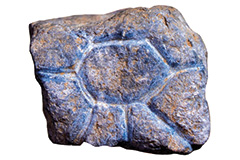 INDONESIA: The ability to create figurative and portable objects of art is a characteristic that researchers believe separates Homo sapiens from our ancestors. Until recently though, little evidence had been found showing that early humans who settled Southeast Asia displayed these capabilities. But 2 tiny incised stone artifacts created between 26,000 and 14,000 years ago found in Leang Bulu Bettue Cave on Sulawesi are filling in this gap. One of the objects depicts an anoa—a local miniature buffalo—and the other displays a sunburst pattern.
INDONESIA: The ability to create figurative and portable objects of art is a characteristic that researchers believe separates Homo sapiens from our ancestors. Until recently though, little evidence had been found showing that early humans who settled Southeast Asia displayed these capabilities. But 2 tiny incised stone artifacts created between 26,000 and 14,000 years ago found in Leang Bulu Bettue Cave on Sulawesi are filling in this gap. One of the objects depicts an anoa—a local miniature buffalo—and the other displays a sunburst pattern. -
 AUSTRALIA: While excavating the Ladies’ Cottage, a former women’s mental health asylum in Tasmania, archaeologists learned about one inmate’s curious behavior through a surprising discovery. More than 1,000 objects were found hidden beneath the veranda, including bundles of newspaper, food wrappers, articles of clothing, and other personal objects. Researchers believe an unidentified woman may have entered the crawl space through a trapdoor and discreetly stashed the items between the 1920s and 1940s as a way of creating her own private space apart from asylum life.
AUSTRALIA: While excavating the Ladies’ Cottage, a former women’s mental health asylum in Tasmania, archaeologists learned about one inmate’s curious behavior through a surprising discovery. More than 1,000 objects were found hidden beneath the veranda, including bundles of newspaper, food wrappers, articles of clothing, and other personal objects. Researchers believe an unidentified woman may have entered the crawl space through a trapdoor and discreetly stashed the items between the 1920s and 1940s as a way of creating her own private space apart from asylum life.
Advertisement
IN THIS ISSUE
Features
From Head to Toe in the Ancient Maya World
A Silk Road Renaissance
Idol of the Painted Temple
Letter from Normandy
Digs & Discoveries
The Emperor of Stones
Off the Grid
Ice Age Ice Box
Sticking Its Neck Out
ID'ing England's First Nun
Play Ball!
History in Ice
Roman River Cruiser
Prized Polo...Donkeys?
Twisted Neanderthal Tech
Around the World
Prehistoric Floridian fishermen, Hannibal’s army in Spain, Paleolithic mystery spheres, and a lost Maya city
Artifact
A Roman soldier’s gift to the gods
Advertisement

Recent Issues
-
 May/June 2024
May/June 2024
-
 March/April 2024
March/April 2024
-
 January/February 2024
January/February 2024
-
 November/December 2023
November/December 2023
-
 September/October 2023
September/October 2023
-
 July/August 2023
July/August 2023
-
 May/June 2023
May/June 2023
-
 March/April 2023
March/April 2023
-
 January/February 2023
January/February 2023
-
 November/December 2022
November/December 2022
-
 September/October 2022
September/October 2022
-
 July/August 2022
July/August 2022
-
 May/June 2022
May/June 2022
-
 March/April 2022
March/April 2022
-
 January/February 2022
January/February 2022
-
 November/December 2021
November/December 2021
-
 September/October 2021
September/October 2021
-
 July/August 2021
July/August 2021
-
 May/June 2021
May/June 2021
-
 March/April 2021
March/April 2021
-
 January/February 2021
January/February 2021
-
 November/December 2020
November/December 2020
-
 September/October 2020
September/October 2020
-
 July/August 2020
July/August 2020
-
 May/June 2020
May/June 2020
-
 March/April 2020
March/April 2020
-
 January/February 2020
January/February 2020
-
 November/December 2019
November/December 2019
-
 September/October 2019
September/October 2019
-
 July/August 2019
July/August 2019
-
 May/June 2019
May/June 2019
-
 March/April 2019
March/April 2019
-
 January/February 2019
January/February 2019
-
 November/December 2018
November/December 2018
-
 September/October 2018
September/October 2018
-
 July/August 2018
July/August 2018
-
 May/June 2018
May/June 2018
-
 March/April 2018
March/April 2018
-
 January/February 2018
January/February 2018
-
 November/December 2017
November/December 2017
-
 September/October 2017
September/October 2017
-
 July/August 2017
July/August 2017
-
 May/June 2017
May/June 2017
-
 March/April 2017
March/April 2017
-
 January/February 2017
January/February 2017
-
 November/December 2016
November/December 2016
-
 September/October 2016
September/October 2016
-
 July/August 2016
July/August 2016
-
 May/June 2016
May/June 2016
-
 March/April 2016
March/April 2016
-
 January/February 2016
January/February 2016
-
 November/December 2015
November/December 2015
-
 September/October 2015
September/October 2015
-
 July/August 2015
July/August 2015
-
 May/June 2015
May/June 2015
-
 March/April 2015
March/April 2015
-
 January/February 2015
January/February 2015
-
 November/December 2014
November/December 2014
-
 September/October 2014
September/October 2014
-
 July/August 2014
July/August 2014
-
 May/June 2014
May/June 2014
-
 March/April 2014
March/April 2014
-
 January/February 2014
January/February 2014
-
 November/December 2013
November/December 2013
-
 September/October 2013
September/October 2013
-
 July/August 2013
July/August 2013
-
 May/June 2013
May/June 2013
-
 March/April 2013
March/April 2013
-
 January/February 2013
January/February 2013
-
 November/December 2012
November/December 2012
-
 Sep/Oct 2012
Sep/Oct 2012
-
 September/October 2012
September/October 2012
-
 July/August 2012
July/August 2012
-
 May/June 2012
May/June 2012
-
 March/April 2012
March/April 2012
-
 January/February 2012
January/February 2012
-
 November/December 2011
November/December 2011
-
 September/October 2011
September/October 2011
-
 July/August 2011
July/August 2011
-
 May/June 2011
May/June 2011
-
 March/April 2011
March/April 2011
-
 January/February 2011
January/February 2011
Advertisement






